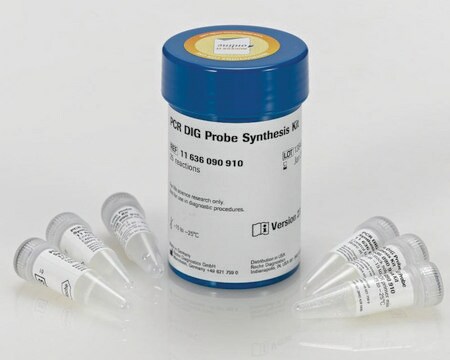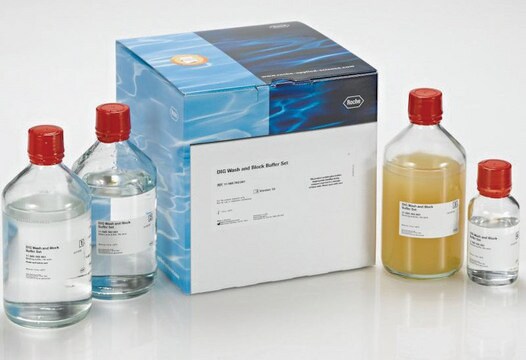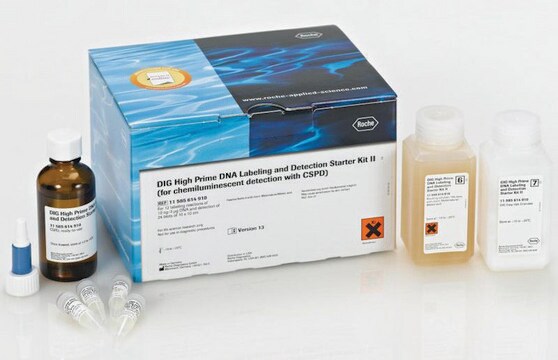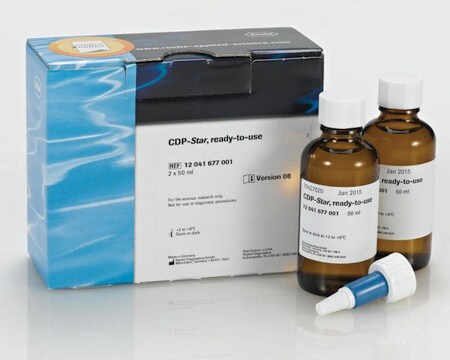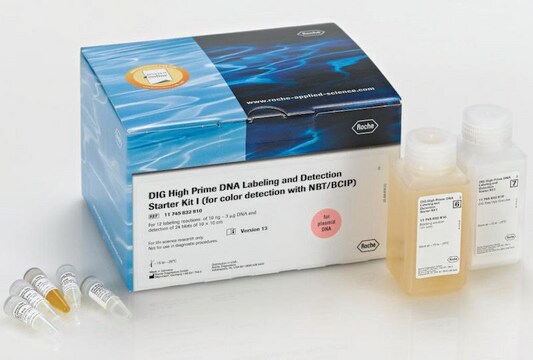12039672910
Roche
DIG Northern Starter Kit
suitable for Northern blotting, sufficient for 10 labeling reactions
Synonyme(s) :
DIG system, Northern blot
About This Item
Produits recommandés
Utilisation
sufficient for 10 blots (blots of 10 x 10 cm2)
sufficient for 10 labeling reactions
Niveau de qualité
Fabricant/nom de marque
Roche
Caractéristiques du produit alternatif plus écologique
Designing Safer Chemicals
Learn more about the Principles of Green Chemistry.
sustainability
Greener Alternative Product
Paramètres
68 °C optimum reaction temp.
Technique(s)
Northern blotting: suitable
Autre catégorie plus écologique
Température de stockage
−20°C
Description générale
Application
Conditionnement
1 kit for up to 10 labeling reactions and detection of 10 blots, blots of 10×10cm2, reactions of μg DNA, yielding approx. 20μg labeled RNA, each
Notes préparatoires
Assay Time: 9 hours 30 minutes
Sample Materials:
- Linearized plasmid, including the appropriate RNA polymerase promoter sequence (SP6, T3, T7).
- Specially prepared PCR productWorking solution: Note: Use sterile, RNase-free solutions and equipment.
Note: The length of the region to be transcribed should be in the range of 200 to 1,000 bp. To avoid RNase contamination the DNA must be phenolized.
Autres remarques
Composants de kit seuls
- Labeling Mix 5x concentrated
- Transcription Buffer 5x concentrated
- SP6 RNA Polymerase 20 U/μl
- T7 RNA Polymerase 20 U/μl
- T3 RNA Polymerase 20 U/μl
- Anti-Digoxigenin-AP antibody, Fab fragments 750 U/ml
- DNase I, RNase free 10 U/μl
- CDP-Star ready-to-use
- Actin RNA Probe, DIG-labeled Antisense Probe, length 588 bases 10 ng/μl
- DIG Easy Hyb Granules
- Blocking Solution 10x concentrated
Mention d'avertissement
Danger
Mentions de danger
Conseils de prudence
Code de la classe de stockage
12 - Non Combustible Liquids
Classe de danger pour l'eau (WGK)
WGK 3
Point d'éclair (°F)
does not flash
Point d'éclair (°C)
does not flash
Certificats d'analyse (COA)
Recherchez un Certificats d'analyse (COA) en saisissant le numéro de lot du produit. Les numéros de lot figurent sur l'étiquette du produit après les mots "Lot" ou "Batch".
Déjà en possession de ce produit ?
Retrouvez la documentation relative aux produits que vous avez récemment achetés dans la Bibliothèque de documents.
Les clients ont également consulté
Articles
Digoxigenin (DIG) labeling methods and kits for DNA and RNA DIG probes, random primed DNA labeling, nick translation labeling, 5’ and 3’ oligonucleotide end-labeling.
Protocoles
In general, it is possible to use DNA probes for northern blots (PCR or random-primed DNA probes). It is however important to keep in mind that DNA probes are best detecting abundant messages, such as housekeeping genes.
Notre équipe de scientifiques dispose d'une expérience dans tous les secteurs de la recherche, notamment en sciences de la vie, science des matériaux, synthèse chimique, chromatographie, analyse et dans de nombreux autres domaines..
Contacter notre Service technique